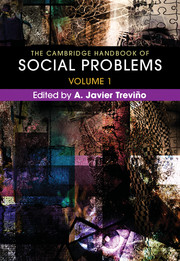Book contents
- The Cambridge Handbook of Social Problems
- The Cambridge Handbook of Social Problems
- Copyright page
- Contents
- About the Contributors
- Introduction
- Part I General Concerns and Orientations in the Study of Social Problems
- Chapter 1 The Challenges of Conceptualizing Social Problems
- Chapter 2 Research Methods
- Chapter 3 Participatory Action Research and Social Problems
- Chapter 4 Public Policy and Social Problems: Recent Trends in the Formal Control of Individual Behavior
- Chapter 5 Social Problems in Global Perspective
- Chapter 6 Bridging Social Movements and Social Problems
- Chapter 7 Public Sociology and Social Problems
- Chapter 8 Service Sociology and Social Problems*
- Chapter 9 Astrosociology: Social Problems on Earth and in Outer Space
- Chapter 10 Prospects for the Sociological Study of Social Problems*
- Part II Historical and Theoretical Issues in the Study of Social Problems
- Part III Problems of Discrimination and Inequality
- Part IV Problems of Institutions
- Index
- References
Chapter 3 - Participatory Action Research and Social Problems
from Part I - General Concerns and Orientations in the Study of Social Problems
Published online by Cambridge University Press: 16 March 2018
- The Cambridge Handbook of Social Problems
- The Cambridge Handbook of Social Problems
- Copyright page
- Contents
- About the Contributors
- Introduction
- Part I General Concerns and Orientations in the Study of Social Problems
- Chapter 1 The Challenges of Conceptualizing Social Problems
- Chapter 2 Research Methods
- Chapter 3 Participatory Action Research and Social Problems
- Chapter 4 Public Policy and Social Problems: Recent Trends in the Formal Control of Individual Behavior
- Chapter 5 Social Problems in Global Perspective
- Chapter 6 Bridging Social Movements and Social Problems
- Chapter 7 Public Sociology and Social Problems
- Chapter 8 Service Sociology and Social Problems*
- Chapter 9 Astrosociology: Social Problems on Earth and in Outer Space
- Chapter 10 Prospects for the Sociological Study of Social Problems*
- Part II Historical and Theoretical Issues in the Study of Social Problems
- Part III Problems of Discrimination and Inequality
- Part IV Problems of Institutions
- Index
- References
Summary
This chapter focuses on understanding participatory action research (PAR) in both concept and practice. I begin by considering PAR in the context of social problems and knowledge power inequality. This allows me to construct a working definition of PAR and then compare variations on this basic definition. Next, I discuss research methods and ethical foundations for PAR practice. Finally, I explore PAR practice, beginning with a researcher's first contact with a community organizing group and moving through the stages of project development, project implementation, and project completion and exit.
- Type
- Chapter
- Information
- The Cambridge Handbook of Social Problems , pp. 39 - 56Publisher: Cambridge University PressPrint publication year: 2018

